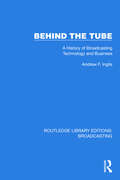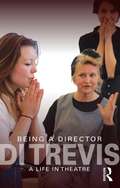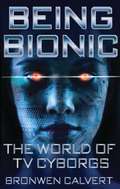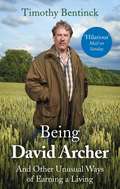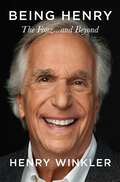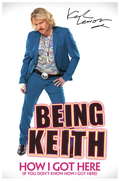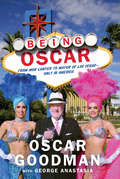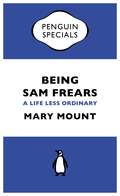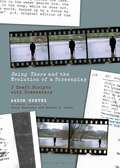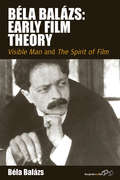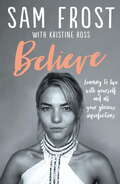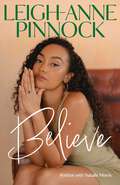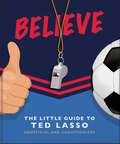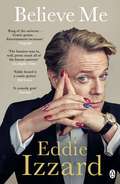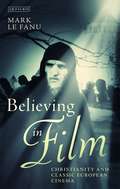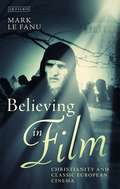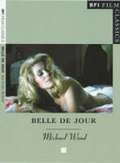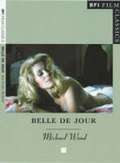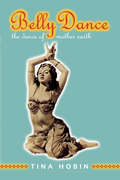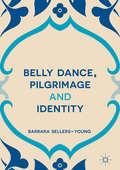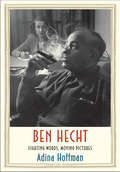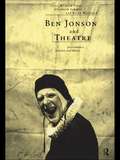- Table View
- List View
Behind the Tube: A History of Broadcasting Technology and Business (Routledge Library Editions: Broadcasting #5)
by Andrew F. InglisBehind the Tube (1990) tells the story of the unseen foundation of modern radio, TV and cable – the technology that enables programming to reach an audience. It charts the evolution of this technology in all its facets – technical, personal, economic and social. It captures the efforts, strategies, achievements and failures of prominent and unheralded figures and companies in the dynamic and competitive broadcast industry.
Being a Director: A Life in Theatre
by Di TrevisDi Trevis is a world-renowned director, whose work with Britain’s National Theatre, Royal Shakespeare Company, and directing productions worldwide, has deeply informed her knowledge of the director’s craft. In Being a Director, she draws on a wealth of first-hand experience to present an immersive, engaging and vital insight into the role of a director. The book elegantly blends the personal and the pedagogical, illustrating how the parameters of Time, Space and Motion are essential when creating a successful production. Throughout, the author explores and recycles her own formative life experiences in order to demonstrate that who you are is as integral to being a director as what you do.
Being a Director: A Life in Theatre
by Di TrevisDi Trevis is a world-renowned director, whose work with Britain’s National Theatre, Royal Shakespeare Company, and directing productions worldwide, has deeply informed her knowledge of the director’s craft. In Being a Director, she draws on a wealth of first-hand experience to present an immersive, engaging and vital insight into the role of a director. The book elegantly blends the personal and the pedagogical, illustrating how the parameters of Time, Space and Motion are essential when creating a successful production. Throughout, the author explores and recycles her own formative life experiences in order to demonstrate that who you are is as integral to being a director as what you do.
Being Bionic: The World of TV Cyborgs
by Bronwen CalvertThe contradictions and complexities of the cyborg therefore hold particular appeal to programme makers of dramatic TV narratives. Bronwen Calvert examines the uses and representations of the cyborg in this ground-breaking text, by looking at its frequent appearance in a wide variety of popular and cult shows: from the iconic Daleks of Doctor Who and bionic female empowerment in Terminator: The Sarah Connor Chronicles, to the duality of humanoid and distinctly robotic cyborgs in Battlestar Galactica. In doing so, she reveals how television's defining traits shape our experience of cyborgs and help us as viewers to question contemporary issues such as surveillance and terrorism, as well as the function of simulation and ultimately what it means to be human.
Being Bionic: The World of TV Cyborgs (Investigating Cult TV)
by Bronwen CalvertThe cyborg – an organic body augmented with technology – is an enduring figure that can be found across science fiction stories, novels, films, and, more recently, television. What can its marked presence in cult TV shows tell us about the rapidly changing world we live in, and indeed about the human condition? This book explores how the image of the cyborg attracts our fears and fascinations. These bionic creations encourage us, as viewers, to think about our interactions with technology in an age of immediacy and surveillance, reassess our own corporeal experiences, and re-imagine gender binaries and racial differences. Chapters draw together cyborg theory and criticism from science fiction and television studies to analyse a variety of popular series: from Doctor Who to Star Trek: Voyager, and Battle Star Galactica to Terminator: The Sarah Connor Chronicles, the cyborg appears as action hero, villain, or as a reflection of ourselves. Whether manifested in the Daleks, the Cylons, or the Borg, these figures are ideal sites to explore concepts such as replication, uniformity, performance, embodiment and virtuality, and the serial narratives of cult TV the ideal format to analyse changing cyborg representations over time. This book uses the televisual medium as a tool to understand a range of cybernetic characters, forming a notable event
Being David Archer: And Other Unusual Ways of Earning a Living
by Timothy Bentinck'Hilarious' Mail on Sunday'Stylish, very funny memoir' Daily MailTimothy Bentinck has played the part of David Archer in BBC Radio 4's The Archers since 1982. He is also the Earl of Portland and the voice of 'Mind The Gap' on the Piccadilly Line. Aimed primarily at the five million regular Archers listeners, Timothy takes the reader behind the scenes of the longest running drama series in the world, a British institution with a theme tune that Billy Connolly wants to be the National Anthem. But that's not all. With wry, self-deprecating humour, Timothy recounts his enormously varied life - a successful actor in TV, film and theatre, a voice specialist working in every vocal medium. He's also been an HGV truck driver, a US tour guide, a computer programmer and website designer, an inventor with UK and US patents, farm worker, house renovator and he sat as a crossbencher in the House of Lords for three years.Unlike many acting memoirs, this isn't a succession of thespian tales of freezing digs, forgotten lines and name dropping. This is an articulate, funny and thoughtful account of how to survive an insecure life.
Being Henry: The Fonz . . . and Beyond
by Henry WinklerHenry Winkler, launched into prominence by his role as 'The Fonz' in the beloved Happy Days, has transcended the role that made him who he is.Brilliant, funny, and widely-regarded as the nicest man in Hollywood (though he would be the first to tell you that it’s simply not the case, he’s really just grateful to be here), Henry shares in this achingly vulnerable memoir the disheartening truth of his childhood, the difficulties of a life with severe dyslexia, the pressures of a role that takes on a life of its own, and the path forward once your wildest dream seems behind you.Since the glorious era of Happy Days fame, Henry has endeared himself to a new generation with roles in such adored shows as Arrested Development, Parks and Recreation, and Barry, where he’s revealed himself as an actor with immense depth and pathos, a departure from the period of his life when he was so distinctly typecast as 'The Fonz', he could hardly find work.Filled with profound heart, charm, and self-deprecating humor, Being Henry is a memoir about so much more than a life in Hollywood and the curse of stardom. It is a meaningful testament to the power of sharing truth and kindness and of finding fulfillment within yourself.
Being Keith: 69 Ways To Be Successful
by Keith LemonSince being crowned the Northern Businessman of the Year 1993, Keith Lemon has been going from strength to strength and now is regularly seen sandwiched between two bang tidy lasses on the funniest show on telly, CELEBRITY JUICE.In BEING KEITH, Keith Lemon - international ladies man and national treasure - opens up and shares the juiciest parts of his life from the last five years; from selling Securipoles in America and travelling the world to his first encounter with Holly and Fearne and dirty dancing with Paddy - and all the juicy details in between. Packed with photos and illustrations, this is Keith's story of success told in his own unique style. You'll never dream of him in the same way again ... Ooooosh!
Being Oscar: From Mob Lawyer to Mayor of Las Vegas
by Oscar GoodmanIn Being Oscar,one of America&’s most celebrated criminal defense attorneys recounts the stories and cases of his epic life. The Mafia&’s go-to defender, he has tried an estimated 300 criminal cases, and won most of them. His roster of clients reads like a history of organized crime: Meyer Lansky, Nicky Scarfo, and &“Lefty&” Rosenthal, as well as Mike Tyson and boxing promoter Don King, along with a midget, a dentist, and a federal judge.After thirty-five years as a defender, he ran for mayor of Las Vegas, and America&’s greatest Mob lawyer became the mayor of its sexiest city. He was so popular his image appeared on the 5, 25, and 100 chips. While mayor of Vegas, he starred on the screen in Rush Hour 2 and CSI. He is as large a character in the history of organized crime as any of his clients and as legendary a figure in the history of Las Vegas as the entrepreneurs (his friends and clients) who built the city. This is his astonishing story—the truth, the whole truth, and nothing but the truth.
Being Sam Frears: A Life Less Ordinary (Penguin Specials)
by Mary MountThis is Sam Frears' story.This is also the story of an actor, a rock-climber and a man born with an extremely rare genetic disorder only affecting Ashkenazi Jews. Sam was supposed to live to the age of 5. In February, he celebrated his 40th birthday.Challenged by blindness and a body under great stress, Sam Frears is trying to live an ordinary life under extraordinary circumstances His struggles and triumphs offer an illuminating look at the differences - and similarities - that make us human. For those who enjoyed My Left Foot and Stuart: A Life Backwards, this Penguin Special offers a fresh look at what it's like to be Sam.
Being There and the Evolution of a Screenplay: 3 Draft Scripts with Commentary
by Aaron HunterBeing There and the Evolution of a Screenplay provides an insightful look at the drafting of one of Hollywood history's greatest scripts. Being There (1979) is generally considered the final film in Hal Ashby's triumphant 1970s career, which included the likes of Harold and Maude (1971) and Shampoo (1975). The film also showcases Peter Sellers's last great performance. In 2005, the Writers Guild of America included Being There on its list of 101 Best Scripts.Being There and the Evolution of a Screenplay features three versions of the script: an early draft by Jerzy Kosinski, based on his 1970 novel; a second by long-time Ashby collaborator and Oscar-winner Robert C. Jones, which makes substantial changes to Kosinki's; and a final draft written by Jones with Ashby's assistance, which makes further structural and narrative changes. Additionally, the book features facsimile pages from one of Kosinski's copy of the scripts that include handwritten notes, providing readers with valuable insight into the redrafting process. For each version, Ashby scholar Aaron Hunter adds perceptive analysis of the script's development, the relationships of the writers who worked on it, and key studio and production details.This is both a presentation of the script of Being There, and a record of the process of crafting that script – a text that will be of interest to film fans and scholars as well as writers and teachers of screenwriting. Evolution of a Screenplay is the first book of its kind to so amply demonstrate the creative development of a Hollywood script.
Being There and the Evolution of a Screenplay: 3 Draft Scripts with Commentary
by Aaron HunterBeing There and the Evolution of a Screenplay provides an insightful look at the drafting of one of Hollywood history's greatest scripts. Being There (1979) is generally considered the final film in Hal Ashby's triumphant 1970s career, which included the likes of Harold and Maude (1971) and Shampoo (1975). The film also showcases Peter Sellers's last great performance. In 2005, the Writers Guild of America included Being There on its list of 101 Best Scripts.Being There and the Evolution of a Screenplay features three versions of the script: an early draft by Jerzy Kosinski, based on his 1970 novel; a second by long-time Ashby collaborator and Oscar-winner Robert C. Jones, which makes substantial changes to Kosinki's; and a final draft written by Jones with Ashby's assistance, which makes further structural and narrative changes. Additionally, the book features facsimile pages from one of Kosinski's copy of the scripts that include handwritten notes, providing readers with valuable insight into the redrafting process. For each version, Ashby scholar Aaron Hunter adds perceptive analysis of the script's development, the relationships of the writers who worked on it, and key studio and production details.This is both a presentation of the script of Being There, and a record of the process of crafting that script – a text that will be of interest to film fans and scholars as well as writers and teachers of screenwriting. Evolution of a Screenplay is the first book of its kind to so amply demonstrate the creative development of a Hollywood script.
Béla Balázs: <i>Visible Man</i> and <i>The Spirit of Film</i> (Film Europa #10)
by Béla Balázs Erica Carter Rodney LivingstoneBéla Balázs’s two works, Visible Man (1924) and The Spirit of Film (1930), are published here for the first time in full English translation. The essays offer the reader an insight into the work of a film theorist whose German-language publications have been hitherto unavailable to the film studies audience in the English-speaking world. Balázs’s detailed analyses of the close-up, the shot and montage are illuminating both as applicable models for film analysis, and as historical documents of his key contribution – alongside such contemporaries as Arnheim, Kracauer and Benjamin – to critical debate on film in the ‘golden age’ of the Weimar silents.
Believe
by Sam FrostI don't claim to know all the answers; most of the time I'm still figuring it out myself. But what I can do is share an insight into the challenges I've faced from depression, anxiety, social media, toxic relationships, body image issues, and grief. I can offer you tips that have helped me find the light when darkness is all that I could see.When Sam Frost first came to the nation's attention after winning the second season of The Bachelor, it was as though her life was a fairytale. Then a down-to-earth 25-year-old who wore her heart on her sleeve, she captivated Australians far and wide. When that chapter of her life ended, it left Sam heartbroken and facing a public battle with depression and anxiety - but the support she received from people who reached out to detail their own struggles encouraged her to take back control of her story. Since then Sam has kept her connection with the public by being her authentic self - often raw and vulnerable, never hiding behind an illusion of perfection - and always trying to be the best person she can be. She pushed herself to take on a high-profile radio gig and then became an actor. In 2020, with her sister, Kristine, Sam launched BELIEVE by Sam Frost, an online community focusing on mental health, where everyone is included and imperfection is celebrated. In Believe, Sam shares her own experiences navigating dark mental health periods and, alongside Kristine's own insights, offers warm, gentle inspiration and tips to help you come through to the other side of your own. Believe is a personal story, a battle cry and a reassurance for the many of Sam's fans who have struggled as she has.Life isn't perfect, but we can try each day to make it beautiful, and Sam, Kristine and Believe will be your companions through it all.I've had my fair share of battles, and I still believe in the good in the world. I still have faith. I believe that I'm on a journey of self-discovery, of growth and evolution, and I want you to come on the journey with me. Hopefully my story will help you believe in all the beauty life has to offer.
Believe: An empowering and honest memoir from Leigh-Anne Pinnock, member of one of the world's biggest girl bands, Little Mix.
by Leigh-Anne Pinnock'I found my power when I realized it was within me, within my skin and within my soul. It just needed to be set free.' Leigh-Anne Pinnock's life changed overnight when she became part of the first ever girl band to win the X-Factor. The multi-platinum selling supergroup Little Mix, went on to become one of the biggest girl bands of all time.Launched into chart-topping global fame, Leigh-Anne was living her childhood dream of becoming a popstar. But behind the scenes, as a Black woman within an industry and team with little diversity, Leigh-Anne was struggling with her identity and felt completely lost. In her highly anticipated memoir, Leigh-Anne shares her journey from growing up in a mixed-race family in Britain to taking the pop world by storm. Honest and direct, she reveals the challenges and prejudices that stood in her path and how she overcame them by embracing her own power. Sharing the experiences and lessons that have shaped Leigh-Anne, this book will empower us all to challenge the status quo, stand up for what we believe in and go after our dreams.
Believe - The Little Guide to Ted Lasso (The\little Book Of... Ser.)
by Orange Hippo!The phenomenon that is Ted Lasso is not going away any time soon. This super-funny show about an American coach who comes to England to run a Premier League football team has captured the hearts of television watchers around the world – as well as caught the eye of critics and prize-givers worldwide. Perhaps it is the feel-good nature of the show and its timing that has seen it awarded Emmy awards aplenty, as well as many others.But it's more likely that such a funny, sharply scripted, brilliantly delivered comedy of manners, nationality, rationality, relationships and inspiration about someone who is so fundamentally decent and willing to help others, has mass appeal and critical acclaim. The third series is much anticipated, with Apple TV+ declaring that it will be out in 2022.Believe contains amusing quotes from the show, including many classic one-liners from Ted and the rest of the brilliant cast, as well as fun facts and stats about the actors, characters, writers and producers. Not to mention tea, scones and soccer. So let's quit goofing around and get on with it... Whistle! Whistle!SAMPLE QUOTE: 'I think I literally have a better understanding of who killed Kennedy than what is offside.' - Ted LassoSAMPLE FACT: Ted Lasso first appeared in a series of short NBC Sports promos featuring Jason Sudeikis in 2013.
Believe Me: A Memoir of Love, Death and Jazz Chickens
by Eddie IzzardAs heard on BBC Radio Four - Book of the Week . . . A memoir of love, death and jazz chickens, Eddie Izzard's fabulous Believe Me is his ONE AND ONLY AUTOBIOGRAPHY . . .-----------------------------'I know why I'm doing all this,' I said. 'Everything I do in life is trying to get her back. I think if I do enough things . . . that maybe she'll come back.'When Eddie Izzard was six, he and his brother Mark lost their mother. That day, he lost his childhood too. Despite or perhaps because of this, he has always felt he needed to take on things that some people would consider impossible. In Believe Me, Eddie takes us on a journey which begins in Yemen (before the revolution), then takes us to Northern Ireland (before The Troubles), England and Wales, then across the seas to Europe and America. In a story jam-packed with incident he tells of teddy bear shows on boarding school beds, renouncing accountancy for swordfighting on the streets of London and making those first tentative steps towards becoming an Action Transvestite, touring France in French and playing the Hollywood Bowl. Above all, this is a tale about someone who has always done everything his own way (which often didn't work at first) and, sometimes almost by accident but always with grit and determination, achieving what he set out to do. Brimming with the surreal humour and disarming candor of his shows (with occasional digressions), Believe Me tells the story of a little boy who lost his mother yet who has risen to become a star of comedy and drama, a leading advocate of total clothing rights, a British European and extreme runner of marathons, who bestrides the world stage as a world stage bestrider.'King of the Universe . . . Comic genius . . . Entertainment incarnate' Telegraph
Believing in Film: Christianity and Classic European Cinema (Cinema and Society)
by Mark Le FanuWe live in a secular world and cinema is part of that secular edifice. There is no expectation, in modern times, that filmmakers should be believers – any more than we would expect that to be the case of novelists, poets and painters. Yet for all that this is true, many of the greatest directors of classic European cinema (the period from the end of World War II to roughly the middle of the 1980s) were passionately interested not only in the spiritual life but in the complexities of religion itself. In his new book Mark Le Fanu examines religion, and specifically Christianity, not as the repository of theological dogma but rather as an energizing cultural force – an 'inflexion' – that has shaped the narrative of many of the most striking films of the twentieth century. Discussing the work of such cineastes as Eisenstein and Tarkovsky from Russia; Wajda, Zanussi and Kieslowski from Poland; France's Rohmer and Bresson; Pasolini, Fellini and Rossellini from Italy; the Spanish masterpieces of Buñuel, and Bergman and Dreyer from Scandinavia, this book makes a singular contribution to both film and religious studies.
Believing in Film: Christianity and Classic European Cinema (Cinema and Society)
by Mark Le FanuWe live in a secular world and cinema is part of that secular edifice. There is no expectation, in modern times, that filmmakers should be believers – any more than we would expect that to be the case of novelists, poets and painters. Yet for all that this is true, many of the greatest directors of classic European cinema (the period from the end of World War II to roughly the middle of the 1980s) were passionately interested not only in the spiritual life but in the complexities of religion itself. In his new book Mark Le Fanu examines religion, and specifically Christianity, not as the repository of theological dogma but rather as an energizing cultural force – an 'inflexion' – that has shaped the narrative of many of the most striking films of the twentieth century. Discussing the work of such cineastes as Eisenstein and Tarkovsky from Russia; Wajda, Zanussi and Kieslowski from Poland; France's Rohmer and Bresson; Pasolini, Fellini and Rossellini from Italy; the Spanish masterpieces of Buñuel, and Bergman and Dreyer from Scandinavia, this book makes a singular contribution to both film and religious studies.
Belle de Jour (BFI Film Classics)
by Michael WoodSeverine (Catherine Deneuve) is a listless haute bourgeouise wife with a secret afternoon life of prostitution. Her life twists repression and guilt together with uninhibited behaviour, strangled libido with its liberated counterpart. Luis Bunuel was catapulted into cinematic history by his groundbreaking Dali collaboration, Un Chien Andalou, in 1929, but it is Belle de Jour (1967) which inaugurates the extraordinary late phase of his work. It is a film shimmering with reflections on truth, fiction and fantasy, in addition to caustic social insight, as it tells the story of a woman clearing her mind, perhaps, of its ghosts.
Belle de Jour (BFI Film Classics)
by Michael WoodSeverine (Catherine Deneuve) is a listless haute bourgeouise wife with a secret afternoon life of prostitution. Her life twists repression and guilt together with uninhibited behaviour, strangled libido with its liberated counterpart. Luis Bunuel was catapulted into cinematic history by his groundbreaking Dali collaboration, Un Chien Andalou, in 1929, but it is Belle de Jour (1967) which inaugurates the extraordinary late phase of his work. It is a film shimmering with reflections on truth, fiction and fantasy, in addition to caustic social insight, as it tells the story of a woman clearing her mind, perhaps, of its ghosts.
Belly Dance: The Dance of Mother Earth
by Tina HobinTina Hobin - acknowledged expert and practitioner of belly dance, with many years experience of teaching and dancing throughout the world - introduces us to the history of this ancient and mystical dance in an accessible style, both enjoyable and easy to read. Tracing the evolution of belly dance from prehistoric fertility rites, the cult of the shaman and temple dances of Ancient Egypt, she explores how the music and motion of the belly dance featured in the rise and fall of entire empires. Looking also at modern belly dance and its growth across the Western world, Tina Hobin combines the history of dance with an explanation of the health benefits of dance, and a step-by-step guide to modern dance movements. Hobin also asks that we dismiss the commercial exploitation of dance, which is in danger of hiding the art behind this oldest of art forms.
Belly Dance, Pilgrimage and Identity
by Barbara Sellers-YoungThis book examines the globalization of belly dance and the distinct dancing communities that have evolved from it. The history of belly dance has taken place within the global flow of sojourners, immigrants, entrepreneurs, and tourists from the nineteenth to the twenty-first century. In some cases, the dance is transferred to new communities within the gender normative structure of its original location in North Africa and the Middle East. Belly dance also has become part of popular culture’s Orientalist infused discourse. The consequence of this discourse has been a global revision of the solo dances of North Africa and the Middle East into new genres that are still part of the larger belly dance community but are distinct in form and meaning from the dance as practiced within communities in North Africa and the Middle East.
Ben Hecht: Fighting Words, Moving Pictures (Jewish Lives)
by Adina HoffmanA vibrant portrait of one of the most accomplished and prolific American screenwriters, by an award-winning biographer and essayistHe was, according to Pauline Kael, “the greatest American screenwriter.” Jean-Luc Godard called him “a genius” who “invented 80 percent of what is used in Hollywood movies today.” Besides tossing off dozens of now-classic scripts—including Scarface,Twentieth Century, and Notorious—Ben Hecht was known in his day as ace reporter, celebrated playwright, taboo-busting novelist, and the most quick-witted of provocateurs. During World War II, he also emerged as an outspoken crusader for the imperiled Jews of Europe, and later he became a fierce propagandist for pre-1948 Palestine’s Jewish terrorist underground. Whatever the outrage he stirred, this self-declared “child of the century” came to embody much that defined America—especially Jewish America—in his time. Hecht's fame has dimmed with the decades, but Adina Hoffman’s vivid portrait brings this charismatic and contradictory figure back to life on the page. Hecht was a renaissance man of dazzling sorts, and Hoffman—critically acclaimed biographer, former film critic, and eloquent commentator on Middle Eastern culture and politics—is uniquely suited to capture him in all his modes.
Ben Jonson and Theatre: Performance, Practice and Theory
by Richard Cave Elizabeth Schafer Brian WoollandBen Jonson and Theatre is an investigation and celebration of Jonson's plays from the point of view of the theatre practitioner as well as the teacher. Reflecting the increasing interest in the wider field of Renaissance drama, this book bridges the theory/practice divide by debating how Jonson's drama operates in performance. Ben Jonson and Theatre includes: * discussions with and between practitioners * essays on the staging of the plays * edited transcripts of interviews with contemporary practitioners The volume includes contributions from Joan Littlewood, Sam Mendes, John Nettles, Simon Russell Beale and Geoffrey Rush, Oscar-winning actor for Shine.
